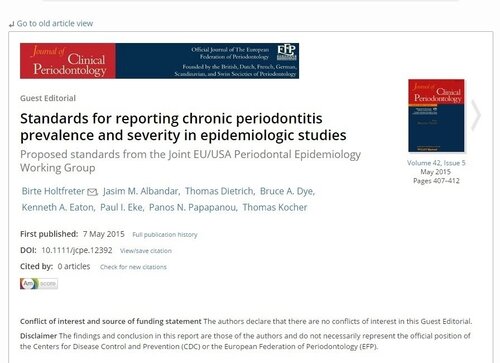![]()
9 July 2015
Joint EU-US working group calls for standardisation in reporting prevalence and severity of periodontal disease
Category:Science

A research paper which could have a huge impact on the way that periodontal scientists report their findings on the prevalence and severity of periodontal illnesses has been published by the EFP’s prestigious Journal of Clinical Periodontology (JCP).
The paper, ‘Standards for reporting chronic periodontitis prevalence and severity in epidemiologic studies’, is the work of the Joint EU/USA Periodontal Epidemiology Working Group, which has sought to create a set of standards to help researchers, epidemiologists, and other health-data users better synthesise published information.
Led by Birte Holtfreter (Ernst Moritz Arndt University, Greifswald, Germany) and Jasmin Albandar (Temple University School of Dentistry, Philadelphia, USA), the paper’s authors note that while periodontal diseases are common, their prevalence varies in different populations.
But scientific research is hindered because the methodologies used by researchers – including measurement techniques, case definitions, and periodontal examination protocols – vary considerably. As a result, it becomes very difficult to draw inferences about global variations in prevalence.
As a way of overcoming these limitations, the authors call for future epidemiological studies to adopt standardised principles for reporting the prevalence and severity of periodontal diseases.
The principles proposed include comprehensive reporting of the study design, the recording protocol, and specific subject-related and oral data. In addition, periodontal data should be reported in relation to both the total population and specific age groups.
This data should include the prevalence and extent of clinical attachment loss (CAL) and probing depth (PD) on site and tooth level according to various criteria: specific thresholds, mean CAL/PD, the CDC/AAP case definition, and bleeding on probing.
According to the authors, the consistent implementation of these standards in future studies “will ensure improved reporting quality, permit meaningful comparisons of the prevalence of periodontal diseases across populations, and provide better insights into the determinants of such variation.”
They add that the use of these standards could improve reporting quality and facilitate the comparison of the distributions of periodontal diseases across populations and countries.
“Improving our understanding of the determinants of periodontitis prevalence and severity will help in devising initiatives that could help reduce the burden of periodontitis worldwide,” they conclude.
The paper, published in Volume 45, Issue 5 (May 2015) of the JCP, was written by Birte Holtfreter, Jasim Albandar, Thomas Dietrich, Bruce Dye, Kenneth Eaton, Paul Eke, Panos Papapanou, and Thomas Kocher. It is available free of charge at the 'Publications' section of the EFP website.
In a video about the research, Thomas Kocher (Ernst Moritz Arndt University) says that the current problems with different definitions and measurement criteria “clearly exemplifies the need for standardised criteria for reporting chronic periodontitis prevalence and severity in epidemiological surveys.”




